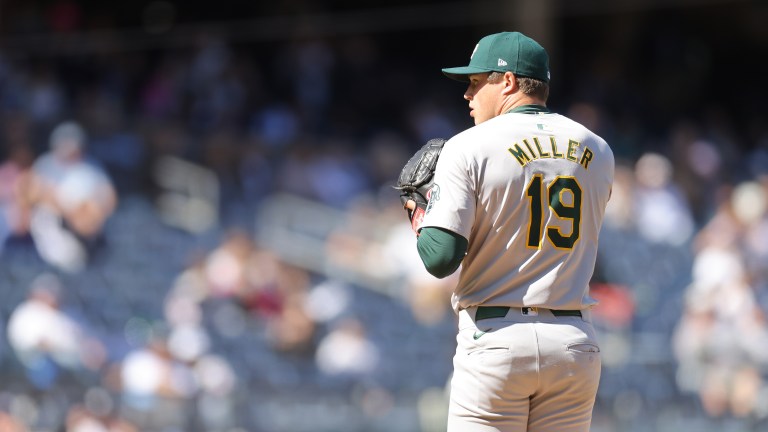Amongst Clouds, Mason Miller is a Star in Oakland
While it is still early in the 2024 season, Mason Miller looks like the most dominant closer in all of baseball.

It’s been a rough calendar year for A’s fans. De-rooting a team with a less than concrete situation in Vegas, not improving the roster, and announcing a temporary move to Sacramento highlight a long list of disasters. Oakland is currently five games under .500 without much of a vision or hope before their eventual relocation.
However, if you somehow manage to crawl through the 500 feet of mud, there is a player breaking out and becoming one of the better bullpen arms in the sport. Mason Miller, a 2021 third-round pick and former starter, moved to the bullpen after injuries ended his starting career.
Quickly elevating himself as the best arm in the A’s ‘pen, Miller grabbed the closer’s role and hasn’t looked back. A fastball that averages 100.7 mph, with a slider sitting 87 mph and a changeup he’s working in that has kept batters off balance.
Although it’s early, just look at these stats from prior to last night’s game.
1.59 ERA, 0.96 xERA, 0.14 FIP, 1.36 xFIP
51% K%, .177 batting average against
0.0% barrel rate, 22.2% hard hit rate, 87 mph EV
Those numbers will only improve after another dominant outing on Friday night, where Miller went toe-to-toe with the Orioles in a one-run game in the extra-innings. With the ghost runner on second base, Miller’s first matchup was against the red-hot rookie Colton Cowser. Strikeout.
Miller then got Hjeston Kerstad to groundout to the second baseman, advancing the game-tying run to third base. Next up, Gunnar Henderson.
Facing off against one of the best young hitters in the game, Miller reared back and blew three fastballs right past Gunnar. The last one clocked in at 102 MPH.
While being five games under .500 is nothing to right home about, if you ask many, the A’s have overachieved up to this point in the season and that is largely due to the impact of Mason Miller.
Mason Miller Has Overpowering Stuff
Crazy numbers to start the season and although the sample is small, Miller’s success is sustainable. How he is getting outs is repeatable when you have the arm talent he possesses. His bread and butter is the 100 mph fastball. A pitch that has generated a 48.3% whiff rate while seeing a bump in spin rate from last season.
You might know Aaron Judge, right? Yeah, that’s him looking out of sorts trying to deal with Miller’s fastball. Even if you know it’s coming, making contact is no walk in the park.
There’s enough movement to avoid batters squaring it up like you might see with other high velo pitchers who’s fastball might appear more “Straight”. Currently, Miller’s fastball has a 130 Stuff+ grade with plus command allowing him to trust the pitch when needed, and cause the slider to be even more effective working off his velocity.
This video really helps tell the story. Batters need to cheat a bit if they have any chance to catch up to 102 mph. Looking fastball and trying to get out in front to make contact, sets up his slider to make you look ridiculous. The slider averages 38.6 inches of drop (vertical movement) and 8 inches of break ( horizontal movement) not to mention the 10+ mph difference in the pitches.

These screen shots are taken from the video above. On the left you can see where both pitches look like they are coming in on the same plane making hitters, who are thinking fastball, confuse the pitch with a slider. On the right, the end locations. How do you expect anyone to consistently adjust and square up a baseball? Especially when you might see him for one at-bat a series?
When you have two pitches that work this well off each other, coming out of the bullpen, a third pitch is not necessary. If Miller does work on developing a changeup it gives him another options against lefties once he’s worked deeper into counts. Good luck batters.
If you look at each batted ball off Miller this season you will notice a trend. Only five balls have traveled over 300 feet and only one was really squared up – a misplayed ball that could have been an out but was awarded a double to Brayan Rocchio. The other four were late swings and flyouts to the opposite field.
Combine the high velocity fastball with a nasty slider and contact is hard enough to make.
When you do make contact it will usually be late resulting in flyouts to the opposite field. Simply put, producing the contact a batter wants to make is not going to happen very often. Add in the improved command and you have a budding star in Oakland.

